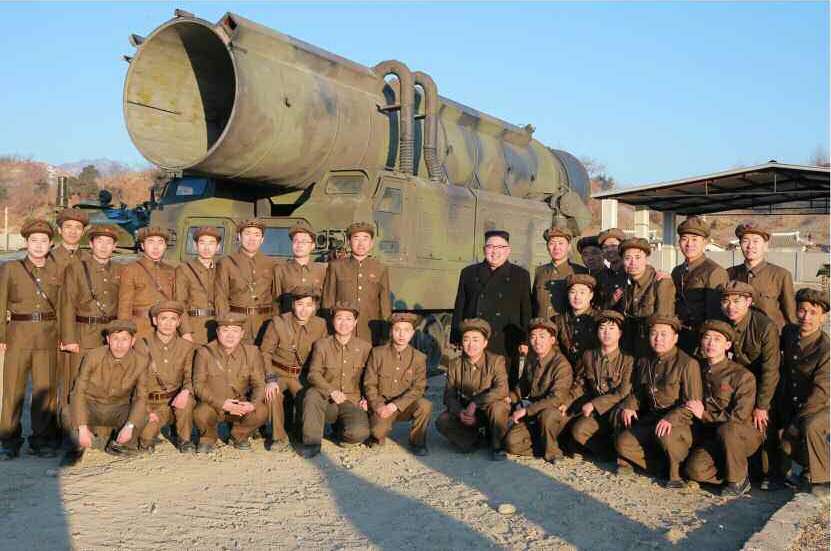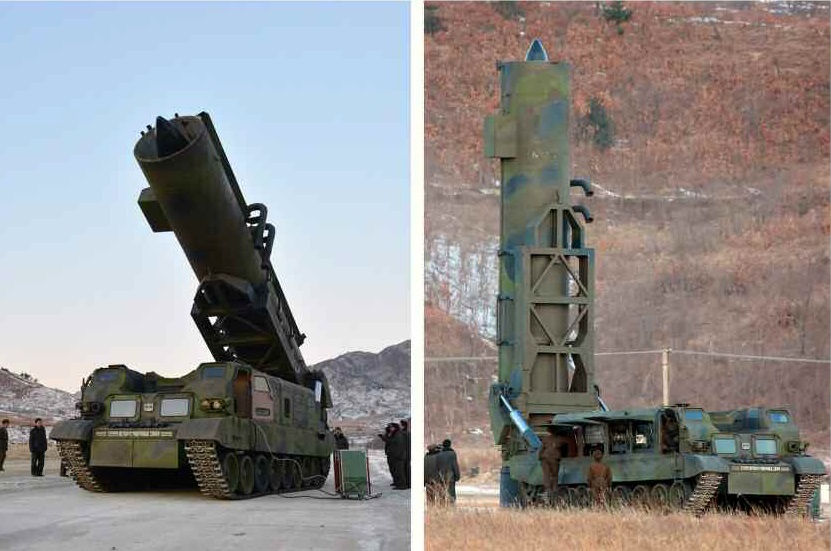Install the app
How to install the app on iOS
Follow along with the video below to see how to install our site as a web app on your home screen.
Note: This feature may not be available in some browsers.
You are using an out of date browser. It may not display this or other websites correctly.
You should upgrade or use an alternative browser.
You should upgrade or use an alternative browser.
Ydinaseet
- Viestiketjun aloittaja Teräsmies
- Aloitus PVM
Onko siinä kyydissä DF-31 vaiko DF-41? Itse arvelen että kyseessä on DF-31.

Jotain muuta naamioituna?
Nojatuolistrategi
Ylipäällikkö
Neuvostoliitto romahti, Venäjän ulkopuolella oli sen 3 429 ydinkärkeä. Miten vaarasta selvittiin?
Entisissä neuvostotasavalloissa, jotka tuolloin saivat itsenäisyyden, oli kaikkiaan 3 429 Neuvostoliiton strategista taistelukärkeä. Kaikkiaan Neuvostoliitolla oli noin 30 000 ydinasetta. Lisäksi oli kemiallisia ja biologisia aseita.
http://www.verkkouutiset.fi/ulkomaat/1nunnlugar-59128
Muistio alkaa toteamalla, että noin 65 prosenttia Neuvostoliiton mannertenvälisistä ydinohjuksista, 35 prosenttia pommittajien aseista ja 45 prosenttia kevyempien pommittajien aseista sijaitsee Venäjällä.
Merkittävä osa oli kuitenkin muualla, kuten Ukrainassa ja Kazakstanissa. Valko-Venäjällä oli prosentti mannertenvälisistä ja 25 prosenttia kevyempien pommittajien ohjuksista.
http://www.verkkouutiset.fi/ulkomaat/2nunnlugar-59130
Ukrainaa saattaa nyt kaduttaa.
Entisissä neuvostotasavalloissa, jotka tuolloin saivat itsenäisyyden, oli kaikkiaan 3 429 Neuvostoliiton strategista taistelukärkeä. Kaikkiaan Neuvostoliitolla oli noin 30 000 ydinasetta. Lisäksi oli kemiallisia ja biologisia aseita.
http://www.verkkouutiset.fi/ulkomaat/1nunnlugar-59128
Muistio alkaa toteamalla, että noin 65 prosenttia Neuvostoliiton mannertenvälisistä ydinohjuksista, 35 prosenttia pommittajien aseista ja 45 prosenttia kevyempien pommittajien aseista sijaitsee Venäjällä.
Merkittävä osa oli kuitenkin muualla, kuten Ukrainassa ja Kazakstanissa. Valko-Venäjällä oli prosentti mannertenvälisistä ja 25 prosenttia kevyempien pommittajien ohjuksista.
http://www.verkkouutiset.fi/ulkomaat/2nunnlugar-59130
Ukrainaa saattaa nyt kaduttaa.
Neuvostoliitto romahti, Venäjän ulkopuolella oli sen 3 429 ydinkärkeä. Miten vaarasta selvittiin?
Entisissä neuvostotasavalloissa, jotka tuolloin saivat itsenäisyyden, oli kaikkiaan 3 429 Neuvostoliiton strategista taistelukärkeä. Kaikkiaan Neuvostoliitolla oli noin 30 000 ydinasetta. Lisäksi oli kemiallisia ja biologisia aseita.
http://www.verkkouutiset.fi/ulkomaat/1nunnlugar-59128
Muistio alkaa toteamalla, että noin 65 prosenttia Neuvostoliiton mannertenvälisistä ydinohjuksista, 35 prosenttia pommittajien aseista ja 45 prosenttia kevyempien pommittajien aseista sijaitsee Venäjällä.
Merkittävä osa oli kuitenkin muualla, kuten Ukrainassa ja Kazakstanissa. Valko-Venäjällä oli prosentti mannertenvälisistä ja 25 prosenttia kevyempien pommittajien ohjuksista.
http://www.verkkouutiset.fi/ulkomaat/2nunnlugar-59130
Ukrainaa saattaa nyt kaduttaa.
Ydinsulku natisee vahvasti, jos maita jotka luopuvat tai eivät kehitä ydinaseita saa vapaasti uhkailla tai jopa valtailla niin maat vetävät omat johtopäätöksensä.
Suomen johtajien pitää olla valtiomiehiä jos ja kun ydinsulku murtuu.
Suomen johtajien pitää olla valtiomiehiä jos ja kun ydinsulku murtuu.
Onko parempi että jokaisella on ase kuin nykyinen tilanne? Henkilökohtaisesti säilyttäisin nämä aseet muissa käsissä kuin minkään valtiovallan, koska historia on osoittanut kerta toisensa jälkeen että tilaisuus tekee varkaan. Lähin historia löytyy somalian merirosvoista. EUn ryöstökalastuksen jälkeen he katsoivat olevan luvallisia tekemään mitä vaan vesille. Mitä jos heillä olisi iso pommi?
Naapurin tapauksessa jos he käyttävät asetta meitä vastaan, niin heidän on tehtävä parhaansa koska kostoisku aivan varma. Käytännössä heidän pitää eliminoida koko kansa ja me tiedämme historiasta kuin hemmetin vaikeaa se toteuttaa käytännössä. Varsinkin euroopassa.
Mutta en sano etteikö naapuri taikka kiina käytä näitä aseita lähitulevaisuussa. Aika näyttää miten sotimisessa mennään kun isot ottavat yhteen. Toivotaan että se pysyy lähellä perinteistä sotimista.
Onko parempi että jokaisella on ase kuin nykyinen tilanne? Henkilökohtaisesti säilyttäisin nämä aseet muissa käsissä kuin minkään valtiovallan, koska historia on osoittanut kerta toisensa jälkeen että tilaisuus tekee varkaan. Lähin historia löytyy somalian merirosvoista. EUn ryöstökalastuksen jälkeen he katsoivat olevan luvallisia tekemään mitä vaan vesille. Mitä jos heillä olisi iso pommi?
Naapurin tapauksessa jos he käyttävät asetta meitä vastaan, niin heidän on tehtävä parhaansa koska kostoisku aivan varma. Käytännössä heidän pitää eliminoida koko kansa ja me tiedämme historiasta kuin hemmetin vaikeaa se toteuttaa käytännössä. Varsinkin euroopassa.
Mutta en sano etteikö naapuri taikka kiina käytä näitä aseita lähitulevaisuussa. Aika näyttää miten sotimisessa mennään kun isot ottavat yhteen. Toivotaan että se pysyy lähellä perinteistä sotimista.
Nykyinen järjestelmä perustuu siihen että ne keillä on ydinaseita luvallisesti takaavat niiden turvallisuuden joilla ei niitä ole, tai näin piti olla..
Nykyinen järjestelmä perustuu siihen että ne keillä on ydinaseita luvallisesti takaavat niiden turvallisuuden joilla ei niitä ole, tai näin piti olla..
Kimillä on niitä ydinpötköjä mutta silti on niin kiinni isoveljen lahkeessa. Olen varma että ei hän pitkälle pötki jos erehtyy niitä käyttämään. Ei pommi ole takaus siitä että mitään ei käy.
Jotain muuta naamioituna?
Saattaa olla myös huhuttu DF-31C mikä olisi tehty kestämään kovempaa offroad rynkytystä.
Trump jakoi näkemyksiään ydinasepolitiikasta.
Donald J. TrumpVarmennettu tili@realDonaldTrump
The United States must greatly strengthen and expand its nuclear capability until such time as the world comes to its senses regarding nukes
OldSkool
Kapteeni
Huhuja (tarkoituksella vuodettuja?) että Venäjä aloittanut testit miehittämättömällä syvällä kulkevalla ja piilossa pysyvällä kauko-ohjatulla torpedolla: https://thebarentsobserver.com/en/security/2016/12/did-russia-test-doomsday-weapon-arctic-waters
Ajatuksena siis viedä todella suuri lämpöydinräjäytys kohdemaan rannikolle ja aiheuttaa kosmisen tason tsunami. Hommaan liittyy rakenteilla oleva Habarovsk-sukellusvene ja Sarov-vene kokeita jne varten.
Venäläisvalmisteinen ydinlataus kauko-ohjauksella pötköttämään jonnekin Washingtonin edustalle ... ettei olisi Tupolevin tekniikkaa mukana. Ympäristöjärjestöt herätys!
Ajatuksena siis viedä todella suuri lämpöydinräjäytys kohdemaan rannikolle ja aiheuttaa kosmisen tason tsunami. Hommaan liittyy rakenteilla oleva Habarovsk-sukellusvene ja Sarov-vene kokeita jne varten.
Venäläisvalmisteinen ydinlataus kauko-ohjauksella pötköttämään jonnekin Washingtonin edustalle ... ettei olisi Tupolevin tekniikkaa mukana. Ympäristöjärjestöt herätys!
tulikomento
Supreme Leader
Trinity & Beyond "atomipommielokuva" on julkaistu uudelleen paranneltuna versiona.
Trinity tuli aikoinaan VHS:ältä katsottua puhki
Myös A guide to armageddon, Threads, The 8th day yms on katsottavia dokkareita.
Sama homma. Tämä tuli 90-luvun lopulla telkusta ja nauhotin VHS:lle. Harmi vaan että paska videoni sittemmin söi nauhan. Mutta, juuri tänään postiluukusta tipahti sisään dokkarin DVD-versio.


tulikomento
Supreme Leader
Mielenkiintoinen dokumentti, jonka aiheena on amerikkalaisten vuonna 1954 Bikinin atollilla tekemä ydinkoe Castle-Bravo. Lämpöydinräjähteen tuotto piti olla 5 megatonnia, mutta paukku olikin 15 megatonnia. Tämä tehonlisäys ja laskeuma pääsi yllättämään tiedemiehet. Samoin tässä käsitellään myös neukkujen Tsar Bomban räjäyttämistä.
https://warisboring.com/saddam-huss...e-during-the-gulf-war-7f1a2432925c#.rmrqqusuuEven before his regime invaded and annexed the oil-rich sheikdom of Kuwait on Aug. 2, 1990, Iraqi dictator Saddam Hussein clearly feared the possibility of a retaliatory Anglo-American nuclear attack on Iraq.
And for good reason. Washington indeed hinted that nukes were on the table.
“I know if the going gets hard, then the Americans or the British will use the atomic weapons against me, and so will Israel,” Hussein told his advisors one month before his troops stormed into Kuwait, according to analysis of hours of audio tape by the Conflicts Records Research Center.
“The only thing I have are chemical and biological weapons, and I shall have to use them,” Hussein added. “I have no alternative.”
Ironically, Hussein’s willingness to even consider deploying his non-nuclear weapons of mass destruction was the major reason the Americans raised the prospect of deploying their own WMDs.
Peuhkis
Luutnantti
Jätän tämän vain tänne. Kuunnelkaa jos ydinaseet ja kylmän sodan analyysi kiinnostaa. Ei oo pakko kuunnella yhteen putkeen. 
http://www.dancarlin.com/hardcore-history-59-the-destroyer-of-worlds/

http://www.dancarlin.com/hardcore-history-59-the-destroyer-of-worlds/
Viimeksi muokattu:
Nurkantakanen
Kapteeni
Siirsin kirjat säikeeseen.
Viimeksi muokattu:
In Reuters Interview President Trump Flunks Nuclear 101
https://fas.org/blogs/security/2017/02/trump-flunks-nuclear-101/Building up the US nuclear arsenal would be an unnecessary, unaffordable, and counterproductive move. It is unnecessary because the US military already has more nuclear weapons than it needs to meet US national and international security commitments. It would be unaffordable because the Pentagon will have problems paying for the nuclear modernization program initiated by the Obama administration. And it is counterproductive because it would further fuel nuclear buildups in other nuclear weapon states.
The claim that the US has “fallen behind on its nuclear weapons capacity” is also wrong; the US has the nuclear weapons capability it needs to meet its national and international security commitments. All nuclear-armed states have different nuclear weapons capacities depending on their individual needs. Nuclear planning is not a race but a strategy.
In terms of capacity, the United States is already at the “top of the pack” with highly capable nuclear forces that are backed up by overwhelming conventional forces. See here how the US nuclear arsenal compares with other nuclear-armed states.
tulikomento
Supreme Leader
BBC:n dramatisoitu dokumentti siitä miten vetypommi kehitettiin 50-luvun alussa. Päähenkilöitä tarinassa mm. Robert Oppenheimer ja Edward Teller.
On Deterrence is a documentary that presents a contemporary dialogue involving different viewpoints about the evolution of nuclear weapon deterrence since World War II and how deterrence may evolve in the future. The intent of this film is not to advocate any one viewpoint, but to make a lasting contribution to the history of deterrence and to the long-term dialogue about the role of U.S. nuclear weapons as a deterrent.
The film features interviews from more than 30 experts, including: National Nuclear Security Administration head Gen. Frank Klotz; Ploughshares Fund president Joseph Cirincione; former U.S. senators Sam Nunn of Georgia and Jon Kyl of Arizona; Carnegie Endowment for International Peace senior associates Ashley Tellis and James Acton; former secretaries of defense James Schlesinger, Robert Gates and William Perry; former Los Alamos National Laboratory director Sig Hecker; Stanford University senior fellow Scott Sagan; and Rose Gottemoeller, former under secretary for Arms Control and International Security at the State Department.
SAND2016-10017 V
Copyright 2016 Sandia Corporation. Under the terms of Contract DE-AC04-94AL85000, there is a non-exclusive license f




